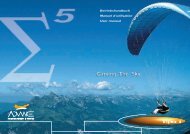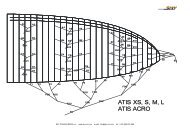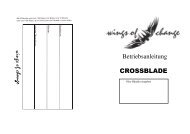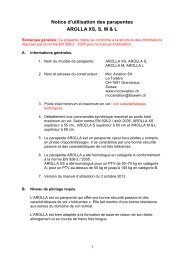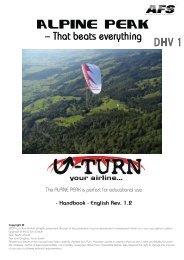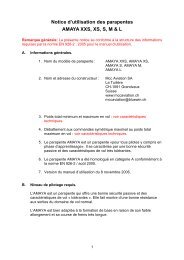Boxtair Betriebsanleitung - Free
Boxtair Betriebsanleitung - Free
Boxtair Betriebsanleitung - Free
Create successful ePaper yourself
Turn your PDF publications into a flip-book with our unique Google optimized e-Paper software.
B-line stallThe B-line stall is another way to descend rapidly and has a sink rate of approximately8 m/s. It is suitable where there is an average ascent rate and little wind.Starting themanoeuvreGrasp both of the B-risers at the coloured mark. Pull both of them slowly and evenlytowards your chest until the airflow is gone and the wing goes into a vertical descentflight mode. The B-risers should then be held in the same position to ensure a gentledescent.Check before and during the B-line-stall that the airspace beneath you is free.RecoveryReturn the B-risers to their normal position quickly and evenly. If you put the B-risersback too slowly, a deep stall or negative spin could occur.Caution! Accident risk!The canopy speeds up after the B-risers have been released. Under no circumstancesshould you apply the brakes at this time.TipIf the paraglider does not speed up immediately because recovery is too slow or forsome other reason, accelerate using the speed system or pull the A-risers forwards.Big ears"Big ears" is another way to descend quickly and has a sink rate of approximately 3 to5 m/s. The forward speed stays the same. You can use the "big ears" method togetherwith the speed system. It is suitable for avoiding a dangerous situation where there arehigh ascent rates and strong wind.Starting themanoeuvreRecoveryPull both outer A-risers downwards. You can now descend safely on the stable middlepart of the wing. Steer by weight-shifting The brakes must not be applied during themanoeuvre, e.g. by wrapping the brakes.Let go of both A-risers. If the ears do not open automatically, assist the openingprocess by pumping the brakes.Caution! Accident risk!When the technique of "big ears" is used, there is a higher load for the line groupswhich are still weight-bearing. Do not fly any extreme manoeuvres with "big ears".12



